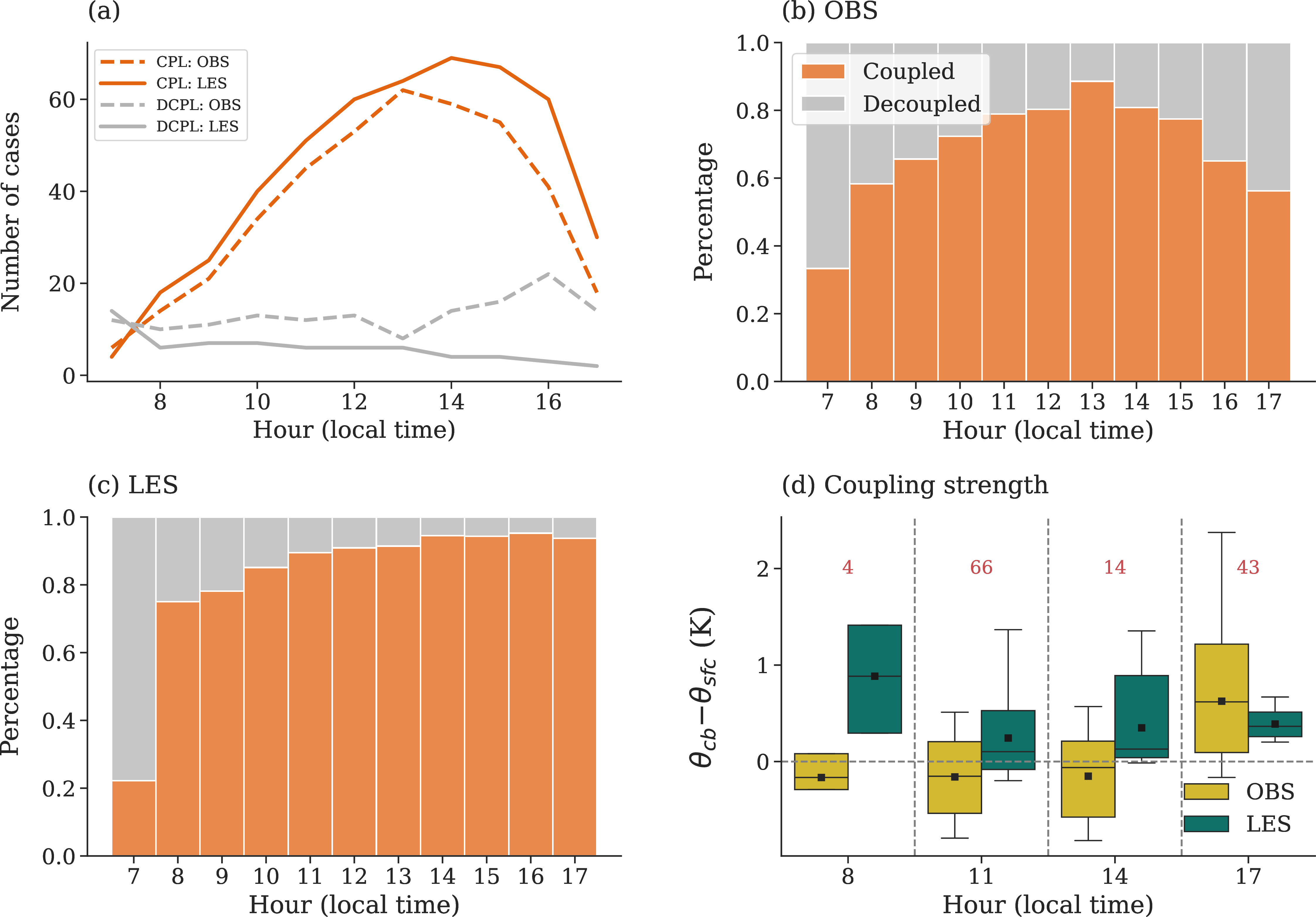First assessment of cloud-land coupling in LASSO large-eddy simulations
Submitter
Li, Zhanqing — University of Maryland
Zhang, Haipeng — University of Maryland, College Park
Area of Research
Cloud Processes
Journal Reference
Zhang H, T Su, Y Zheng, and Z Li. 2024. "First Assessment of Cloud‐Land Coupling in LASSO Large‐Eddy Simulations." Geophysical Research Letters, 51(14), e2024GL109774, 10.1029/2024GL109774.
Science

Comparison of coupled/decoupled cumulus cloud cases between LASSO LESs and observations at the SGP site. (a) Number of cases for coupled and decoupled clouds for each hour. Panels (b)-(c) show the percentage of coupled and decoupled cloud cases relative to their total count from observations and LES runs, respectively. (d) Stratification of sub-cloud layers at four different hours, with boxplots showing the 10th, 25th, 50th, 75th, and 90th percentiles. The black square indicates the mean, and the red number above shows the sample size per hour. Figure from journal.
Cloud-surface coupling is crucial in weather predictions and climate change studies, yet its processes, particularly over the land, remain poorly understood. The Large-Eddy Simulation (LES) Atmospheric Radiation Measurement (ARM) Symbiotic Simulation and Observation (LASSO) activity provides fine-resolution simulations of shallow convection cases at the ARM user facility's Southern Great Plains (SGP) site in Oklahoma, enabling a process-level understanding of cloud and planetary boundary-layer (PBL) processes. Despite the importance of cloud-surface coupling on PBL processes (e.g., PBL stability transition), its representation in LASSO LESs remains unknown. Being the state-of-the-art process modeling technique, LASSO’s performance in simulating the coupling can shed light on our understanding of cloud-land interactions. A thorough examination of cloud-surface coupling is thus conducted, and our findings not only help improve the accuracy of cloud simulations in future LASSO experiments but also refine the representation of cloud-aerosol interactions near the surface, considering the influence of coupling on the PBL vertical mixing of aerosols.
Impact
This study provides the first assessment of coupling between cloud and land surface in LASSO LESs for the shallow convection scenario. The analysis of observation data reveals a diurnal cycle of cloud-land coupling, which co-varies with surface fluxes. However, the states of coupling are inadequately simulated, manifesting as a too-high occurrence frequency for coupled clouds (and too-low for decoupled clouds) during the afternoon, consistent with overestimated cloud liquid water path and cloud-top height. These overestimations are linked to the overpredicted boundary-layer development and the easier trigger of shallow convection misrepresented in LES runs. This study underscores the need to improve the representations of boundary-layer processes and cloud-land interactions within LESs, e.g., employing an interactive land surface model, to better simulate shallow clouds in the future.
Summary
This study constitutes a preliminary assessment of cloud-land coupling in the LASSO LESs, focusing on 77 case days with shallow convection. Our examination delves into cloud-land coupling processes, comparing LES simulations with observations. The diurnal patterns of coupled cloud occurrence in observations are closely tied to the diurnal variations of surface fluxes. LES runs can broadly capture this evolution but overestimate coupled cloud occurrences in the afternoon, mirrored by the overprediction of cloud liquid water path and the vertical extent of shallow cumulus clouds. These overestimated cloud properties turn out to be a more vigorous PBL simulated by LES runs. The overestimation of coupled cloud occurrence frequency in the afternoon is likely caused by a more efficient trigger of shallow convection represented in the LES model, given the same level of turbulent energy and moisture background. This highlights a deficiency in the representation of cloud-land interactions and boundary-layer processes. Our study underscores the need to enhance cloud-land coupling in LESs, possibly through decreasing the coefficient for the surface-heat-flux term in the turbulent kinetic energy (TKE) budget equation or employing an interactive land surface model.
Keep up with the Atmospheric Observer
Updates on ARM news, events, and opportunities delivered to your inbox
ARM User Profile
ARM welcomes users from all institutions and nations. A free ARM user account is needed to access ARM data.


















